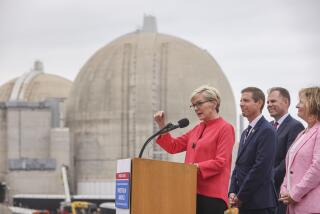U.S. Admits Disrepair at Nuclear Plants
- Share via
WASHINGTON — The government’s nuclear weapons production plants have been allowed to deteriorate so badly over the last 25 years that at least four of them probably will have to be closed permanently and the rest will require at least $81 billion in repairs and cleanup, the Reagan Administration acknowledged Thursday.
The current complex of 15 plants that build and service the nation’s nuclear bombs and warheads are no longer either environmentally safe or secure against terrorist threats, the Administration said in a report. In addition, “public opposition” to nuclear work in heavily populated areas has made some of the plants, particularly the heavily contaminated Rocky Flats facility near Denver, not worth spending the money to improve, it said.
The report, written by a panel of officials from the Energy Department and the Pentagon, contains little information that has not already been released but is the most comprehensive Administration public statement to date on the production plants’ problems.
Its recommendations, stressing the need for more repairs and investment along with some plant closings, are not binding on the new Administration. President-elect Bush, speaking to reporters after announcing that retired Adm. James D. Watkins will be his energy secretary, said that he would not necessarily accept its conclusions.
“I am not committed to any report,” Bush said, adding that he would ask Watkins, whose new department runs the weapons plants, to “immediately take a look” at the problems of the weapons plants. The increased money the report recommends would amount to a 50% increase in the budget for the nuclear program for the next 20 years, an increase that will be difficult to fit into Bush’s plan for a “flexible freeze” on government spending.
Asked if further study of the issue might not increase risks of public harm or environmental damage, Bush replied: “I think there’s a risk if we imprudently go forward (before) he and I have had a chance to take a hard look.”
Watkins, saying that he had not yet had a chance to look at the report, told reporters that the Navy’s experience with reactors proves that nuclear programs can be run safely. “And its about time to demonstrate to the American people we can do it,” he said.
Clean Bill of Health
Indeed, the plants that process uranium for Navy reactors were about the only part of the nation’s production complex that received a clean bill of health in the document. The rest of the plants, which make tritium--a radioactive gas--for hydrogen bombs, process plutonium and construct the bombs all pose problems, it said.
No immediate changes were recommended at the government’s three nuclear weapons laboratories, which include the University of California’s Lawrence Livermore National Laboratory. But because of increased population around the lab, located about 30 miles inland from Oakland, future expansion should be channeled to “a more remote site,” the report suggested.
The study called for substantial changes at the plants that make tritium, which decays rapidly, requiring a steady resupply to keep nuclear bombs ready for use. Those plants, all at the Savannah River facility in South Carolina, are all now shut down and probably will not be able to reopen until the end of the year.
Many of the problems, the report concluded, were caused by federal budget cuts that deferred maintenance.
The result has been that the plants, mostly built in the 1950s and mid-1960s, “are rapidly reaching the end of their useful lives.” Modernizing them will cost at least $52 billion over the next 20 years, the report said. In addition, another $29 billion will be needed to clean up environmental hazards, which include radioactive wastes at some plants and toxic chemicals at others.
Along with modernization, the report suggests consolidation of the weapons plants, concentrating them in a few sites that are remote from population centers.
More to Read
Sign up for Essential California
The most important California stories and recommendations in your inbox every morning.
You may occasionally receive promotional content from the Los Angeles Times.














